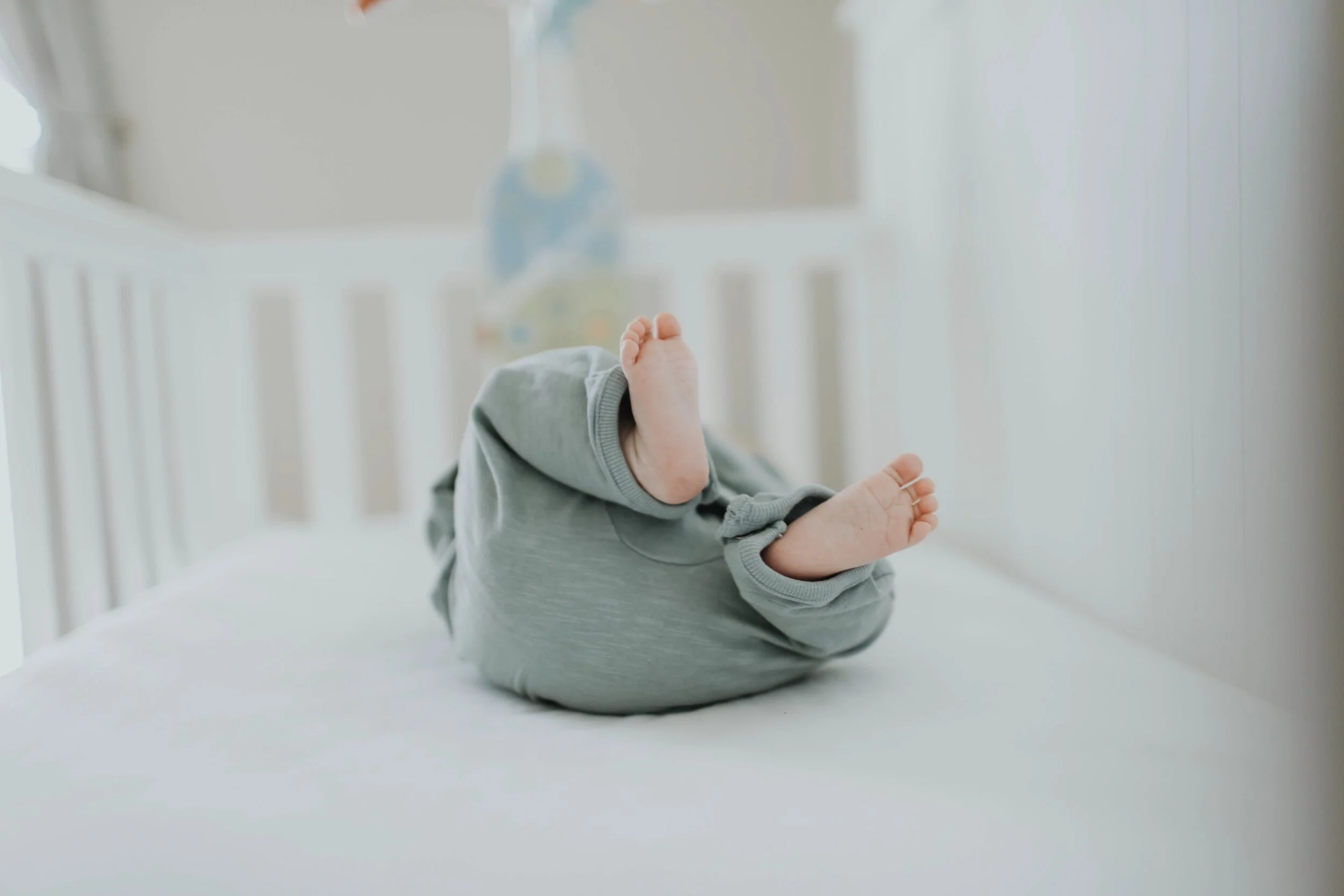American Academy of Pediatrics
Recommendations for a Safe Sleep Environment
Most recent recommendations
released July 2022
1. Back to sleep for every sleep.
To reduce the risk of SIDS, infants should be placed for sleep in a supine position (wholly on the back) for every sleep by every caregiver until the child reaches 1 year of age. Side sleeping is not safe and is not advised.
The supine sleep position does not increase the risk of choking and aspiration in infants (watch this video), even those with gastroesophageal reflux, because infants have airway anatomy and mechanisms that protect against aspiration.9,10 The American Academy of Pediatrics (AAP) concurs with the North American Society for Pediatric Gastroenterology and Nutrition that “the risk of SIDS outweighs the benefit of prone or lateral sleep position on GER [gastroesophageal reflux]; therefore, in most infants from birth to 12 months of age, supine positioning during sleep is recommended.
2. Use a firm, flat, sleep surface.
Infants should be placed on a firm sleep surface (eg, mattress in a safety-approved crib) covered by a fitted sheet with no other bedding or soft objects to reduce the risk of SIDS and suffocation. The incline of the sleep surface should be less than 10 degrees. All sleep surfaces should be approved by the 2021 CPSC guidelines
Sitting devices, such as car seats, strollers, swings, infant carriers, and infant slings, are not recommended for routine sleep. If an infant falls asleep in a sitting device, he or she should be removed from the product and moved to a crib or other appropriate flat surface as soon as is safe and practical.
3. Breastfeeding/Human Milk is recommended.
Breastfeeding is associated with a reduced risk of SIDS. Unless contraindicated, mothers should breastfeed exclusively or feed with expressed milk (ie, not offer any formula or other nonhuman milk-based supplements) for 6 months, in alignment with recommendations of the AAP.
The protective effect of breastfeeding increases with exclusivity. However, any breastfeeding has been shown to be more protective against SIDS than no breastfeeding.
4. room share, don’t bed share, ideally for the first 6 months.
There is evidence that sleeping in the parents’ room but on a separate surface decreases the risk of SIDS by as much as 50%. In addition, this arrangement is most likely to prevent suffocation, strangulation, and entrapment that may occur when the infant is sleeping in the adult bed.
In South Dakota, infants sleeping in an adult bed is a leading cause of infant mortality.
Couches and armchairs are extremely dangerous places for infants. Sleeping on couches and armchairs places infants at extraordinarily high risk of infant death, including SIDS, suffocation through entrapment or wedging between seat cushions, or overlay if another person is also sharing this surface. Therefore, parents and other caregivers should be especially vigilant as to their wakefulness when feeding infants or lying with infants on these surfaces. Infants should never be placed on a couch or armchair for sleep.
5. Nothing but the baby in the bed
Keep soft objects and loose bedding away from the infant’s sleep area to reduce the risk of SIDS, suffocation, entrapment, and strangulation.
Avoid soft objects, such as pillows and pillow-like toys, quilts, comforters, sheepskins, and loose bedding such as blankets and nonfitted sheets that can obstruct an infant’s nose and mouth. An obstructed airway can pose a risk of suffocation, entrapment, or SIDS.
Infant sleep clothing, such as a wearable blanket, is preferable to blankets and other coverings to keep the infant warm while reducing the chance of head covering or entrapment that could result from blanket use. New 2022 recommendations also recommend avoiding hats.
Avoid bumper pads or positioning devices.
6. offer a pacifier at nap time and bedtime.
Although the mechanism is yet unclear, studies have reported a protective effect of pacifiers on the incidence of SIDS. The protective effect of the pacifier is observed even if the pacifier falls out of the infant’s mouth. The pacifier should be used when placing the infant for sleep. It does not need to be reinserted once the infant falls asleep. Because of the risk of strangulation, pacifiers should not be hung around the infant’s neck. Pacifiers that attach to infant clothing should not be used with sleeping infants.
7. Pregnant women should obtain regular prenatal care.
There is substantial epidemiologic evidence linking a lower risk of SIDS for infants whose mothers obtain regular prenatal care. Pregnant women should follow guidelines for the frequency of prenatal visits.
8. Infants should be immunized in accordance with recommendations of the AAP and Cdc.
There is no evidence that there is a causal relationship between immunizations and SIDS. Indeed, recent evidence suggests that vaccination may have a protective effect against SIDS.
9. Supervised, awake tummy time is recommended
Parents are encouraged to place the infant in tummy time while awake and supervised for short periods of time beginning soon after hospital discharge, increasing incrementally to at least 15–30 min total daily by age 7 wk.
10. Avoid smoking, alcohol, and drug use.
All of these are known to increase the risk of sleep-related infant deaths.
11. Avoid use of commercial cardiorespiratory monitors for babies
i.e, Snuza, Owlette, and AngelCare Monitors
Direct-to-consumer heart rate and pulse oximetry monitoring devices, including wearable monitors, are sold as consumer wellness devices. Although use of these monitors may give parents peace of mind, and there is no contraindication to using these monitors, data are lacking that would support their use to reduce the risk of these deaths. There is also concern that use of these monitors will lead to parent complacency and decreased adherence to safe sleep guidelines. A family’s decision to use monitors at home should not be considered a substitute for following AAP safe sleep guidelines.
12. Avoid overheating and hats for sleeping infants.
In general, infants should be dressed appropriately for the environment, with no greater than 1 layer more than an adult would wear to be comfortable in that environment.
Parents and caregivers should evaluate the infant for signs of overheating, such as sweating or the infant’s chest feeling hot to the touch. Overbundling and covering of the face and head should be avoided.
13. Avoid the use of commercial devices that are inconsistent with safe sleep recommendations.
Be particularly wary of devices that claim to reduce the risk of SIDS. Examples include, but are not limited to, wedges and positioners and other devices placed in the adult bed for the purpose of positioning or separating the infant from others in the bed. Crib mattresses also have been developed to improve the dispersion of carbon dioxide in the event that the infant ends up in the prone position during sleep. There is no evidence that any of these devices reduce the risk of SIDS. Importantly, the use of products claiming to increase sleep safety does not diminish the importance of following recommended safe sleep practices.
Information about a specific product can be found on the CPSC Website. The AAP concurs with the US Food and Drug Administration and the CPSC that manufacturers should not claim that a product or device protects against SIDS unless there is scientific evidence to that effect.
14. There is no evidence to recommend swaddling as a strategy to reduce the risk of SIDS.
Swaddling, or wrapping the infant in a light blanket, is often used as a strategy to calm the infant and encourage the use of the supine position. There is a high risk of death if a swaddled infant is placed in or rolls to the prone position. If infants are swaddled, they should always be placed on the back. Swaddling should be snug around the chest but allow for ample room at the hips and knees to avoid exacerbation of hip dysplasia. When an infant exhibits signs of attempting to roll, swaddling should no longer be used.
All Information was taken directly from:
FROM THE AMERICAN ACADEMY OF PEDIATRICS| POLICY STATEMENT| JUNE 21 2022


